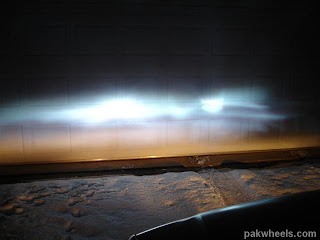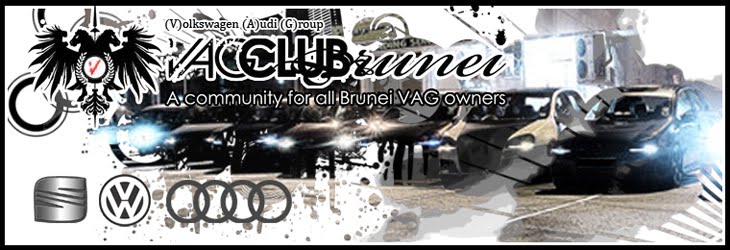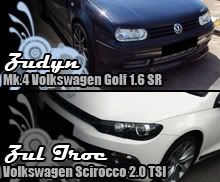Yes we all know HID lighting, Projectors, Reflectors and all those jargon coming out from their mouth thinking they know what they're talking about. But what do we actually know about these stuffs? Do you seriously think:
- Kelvin Temps = Brighter the lights? (I.e. 4300k, 6000k, etc)
- HID Aftermarket kits in reflector type headlamps are legal?
- HID Aftermarket kits in reflector type foglamps are legal?
- Just changing your headlamps to aftermarket projector headlamps would solve the glare problem?
If you answered any one of it "yes", then you're at the right place here. Read on carefully. There's more to it!
For your info, lights that are produced from your car headlamps are not just "lights" dispersed everywhere or the road by whole. So no wonder you thought, "Eh, mun kereta ku pakai HID, sampai ke hujung wah tarang nya".
Well, you're wrong and being inconsiderate to other motorists: You're blinding them with your HID and endangering the chances of having an accident due to temporarily blindness!
They're projected in either LHD/RHD Pattern (depending on the country) so that the light wouldn't blind oncoming traffic! In most Asia region (And UK), we use the Left Hand Drive, so light must project in a beam where the Left side is brighter than the Right side like so:

Imagine that type of luminance projecting the light to the road, now can you understand why does most OEM Headlamps does not blind the other drivers? The light pattern produced from your car headlamps does not allow light going over the horizontal cutoff line.
Now why lamps fitted with HID Aftermarket kits blinds oncoming traffic, despite having the right "Cut-off" pattern? Well, there's just more than the "Cut-off" pattern ladies and gentlemen. Headlamp type, bulb position and the bulb colors all have their role.
------
HID Colors:
You may be confused about which color to choose for your HID conversion kit. The color of the output is determined by the temperature. The lower the temperature (usually around 4300k or so) is the whitest and brightest. As you increase the temperature the color scales as well.
At 6000k you have a light blue, 8000k a deeper blue, 10,000k starts to turns blue/purple and 12,000k starts to turn to purple. I recommend anything between 4300k-8000k to look the best but also be extremely bright.

4300K Pure White
4300K has an approximately 3200lm output, which is more than 3x the light output of the traditional halogen light and is the color temperature with the most output. The light appears fairly white, and has light yellowish hue when reflected off the road identical to the OEM HID equipped vehicles. This color is for people who are looking for pure performance while improving the looks of their headlights. It is ideal for people who does a lot of back road or canyon driving and need the optimal visibility.
6000K Diamond White
6000K has an approximately 2800lm output, which is 3x the light output of the traditional halogen light and slightly less light output compared to the 5000K. Although it has a bit lesser light output, it emits pure white light with very slight and barely noticeable tint of blue and purple.
8000K Iceberg Blue
8000K has an approximately 2550lm output, which is about 3x the light output of the traditional halogen light and slightly less light output compared to the 6000K. While it has a bit lesser light output, it emits a more blue lighting than the 6000K
10000K Brilliant Blue
10000K has an approximately 2200lm output, which is more than 2x the light output of the traditional halogen light. 10000K produces a deep blue light output approaching violet and the blue is noticeably deeper than the 8000K.
12000K Exotic Violet/Purple
12000K has an approximately 2100lm output, which is more than 2x the light output of the traditional halogen light. This color temperature puts out a deep bluish violet light and is deeper colored than the 10000K. It is for a people who are looking for the most extreme and most exotic looking light output.
Bear in mind, anything further than 6000k would no longer be road legal not to mention lights refracted from reflector/projector headlamps would be more and more blinding as the Kelvin gets higher. Despite the higher Lumens than Halogen, white are still much better in terms of lighting projection than other colors.
So... no, higher Kelvin does not means brighter lights!
------
Types of headlamps:
Reflectors
What are reflector types of headlamps? What do they look like? Basically, reflector types headlamps are like multiple mirrors behind the lens that projects the light produced from the bulbs.
Two types of Reflectors would be:
Elliptical Type Reflectors
(Lights are refracted by small patterned ridges on the lens)

Parabolic Type Reflectors
(Lights are refracted by patterned ridges on the reflector itself)

Reflector type headlamps comes mostly in almost all cars in the market (with the exception of higher range model of the particular model), and somewhat comes in Halogen type bulbs. Obviously there's no problem there because Halogen type bulbs normally emits about 1,300 lumens of light. Generally, Reflector type headlamps works best with only Halogen type bulbs.
Because of the reflective nature of the headlamps that once HID Aftermarket kits are installed which produces up to 2,500 lumens of light, basically what made the glare was the bulb producing that much light and you actually looking at the reflectors. Of course, most reflectors aren't designed for HID use unless specified or designed by OEM. With special designed reflectors and proper anti-glare shielding, they are possible.
But then again with so much light produced from the HID Lighting system, you're basically overpowering the design of the lamps. Even if you level the lights low to the ground, other motorists will still be blinded because of the reflective nature of the headlamps.
This is how the light pattern looks like when using HID Aftermarket kit on Reflector type headlamps:
.jpg)
It's nasty, rubbish and looks horrible. Not only it doesn't help you as much just like you're not helping other motorists either while they're trying to drive safely on the road!
So let's move on to Projectors. And still, using projectors alone wouldn't stop the glare until you'll get to use the right type of Projectors!
------
Projectors
Projector types headlamps are known for its 'sphere'-glassy look which always comes on higher-option cars. They project light much better than reflector and for their non reflective-mirror properties.

Like reflector types, there are two types of Projector headlamps:
- Halogen Projectors
- Xenon Projectors
Both works the same way, but the bulbs are position differently. With the Halogen lamps, the bulbs are closer to the shield than Xenon lamps. This is because generally Xenon lamps are much longer than Halogen lamps.
If you have ever ordered from eBay for your headlamps and retrofitted HID Lighting system to it, or even OEM projector lights that used Halogen before: You're doing it wrong! This will still glare oncoming traffic because of the improper spacing between the bulb sitting and the cut-off shield.
Having HIDs in Halogen Projectors setups are terrible. They do fit, well... with probably less output than the original halogen bulb set up. Go with the true projector hid conversion kit; don’t waste your time with the halogen projectors. Research, and ask thoroughly. There are certain sellers would just say yes. ISO and e-Mark may sometimes do prove anything. As long they're UK e-Mark approved for HID lighting, you're good to go.
Well okay, you might not know this but why? Because most eBay headlamps that sells under USD 300 and less are Halogen Projector lamps. It does explain why your lighting quality is sometimes worse than your stock lighting setup.
.jpg)
Notice that light still emits over the horizontal cut-off line. This is basically the 'lightened' version of the Reflectors using HID, which means it still glares or blinds oncoming traffic.
You should start wondering why BMW/Mercedes/Lexus or cars alike using HIDs meets JPD specifications (or heck, even other countries’ MOT requirements) and you whined about why those cars actually met the requirements and not yours.
The only thing you should realize are these cars have met or exceeded their requirement:
- Not to Glare/Blinding oncoming traffic
- Proper Light Projection Leveling (Possibly with auto leveling lights)
- Proper LHD/RHD light pattern.
So how does a total-proper OEM/HID aftermarket kit light pattern should look like? These:
1) Xenon Lamps on RHD Pattern Xenon Projector Headlamp

2) Xenon Lamps on LHD Pattern Xenon Projector Headlamps
.jpg)
3) Halogen Lamps on LHD Pattern Halogen Projector Headlamps
.jpg)
Now that's proper lighting! Notice how sharp the horizontal cut-off is when done right. Not only that, it helps you to make more out of your headlamps by lighting up more of the road space and still not blinding oncoming traffic.
So there you have it. As long you got this guideline in your head, it doesn't mean that it can fool the local laws. Always ask, or heck point them to this article if they're not even sure. Not all HID Aftermarket fitted kits are illegal. If done properly, they can function just as well as OEM HID fitted vehicles and help better drivability and visibility on low-light driving conditions.
More information can be visited here:
1) Click Me (Nicoclub.com)
2) Click Me (Pakwheels.com)












No comments:
Post a Comment